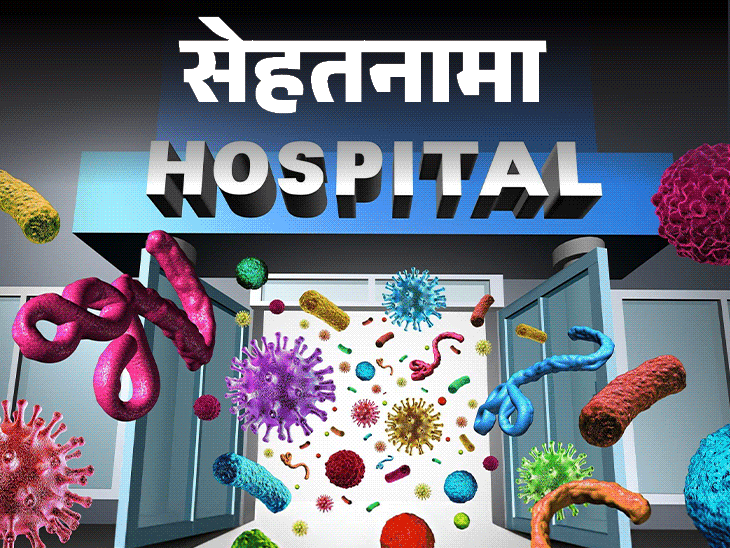India News Get -LifestyleHealth News Every year, millions of people fall ill due to nosocomial infection
When we get sick, we go to the hospital for treatment, but what happens if we catch a new illness in the hospital? Yes, it’s possible. Even after being admitted to the hospital, we can fall prey to a new illness.
In medical language, we speak of nosocomial infection. It is also called HAI (Healthcare Associated Infection). This means infection caused by hospitals. Although it can affect anyone – patient, doctor or caregiver, it is mainly people with weak immunity who become its victims.
so today medical certificate Here we will talk about nosocomial infections that spread from hospitals. You will also learn that-
What are the symptoms of a nosocomial infection? How many types of infections can there be?
Expert: Dr Sheetal Verma, Professor of Clinical Microbiology, King George Medical University, Lucknow
What is a nosocomial infection? This is an infection that can occur in hospital while you are receiving treatment for any illness. These infections can cause serious, even sometimes fatal, pathologies. The risk of HAI persists after arrival at the hospital, 48 hours after hospitalization, three days after discharge from the hospital or surgical center and thirty days after any surgical procedure.
This infection spreads among humans through bacteria, viruses and fungi. It engulfs the person within 48 hours. If not treated in time, it can also lead to serious health problems.
However, most HAIs can be avoided. For this, it is very important to respect safety measures on the part of the medical teams, the patient and their caregiver.
Nosocomial infection statistics According to a report published in the National Library of Medicine, around 10-20% of patients admitted to Indian hospitals contract nosocomial infections. According to the World Health Organization (WHO), more than 14,000,000 people worldwide suffer from it at any time. According to a survey carried out by the WHO in 55 hospitals in 14 countries, on average 8.7% of hospitalized patients suffer from nosocomial infections. Studies show that the infection rate in intensive care units (ICU) is 11-25%.
According to a study by the National Library of Medicine, every year, 13.6 million people around the world suffer from hospital-acquired infections (HAIs), of which 52 million cases come from China, 10 million from Pakistan and approximately 9 million from ‘India.
How many types of nosocomial infections are there? There are many types of nosocomial infections and their occurrence can have many causes.
C. difficile infection: This causes diarrhea and colitis. In this case, more than 16% of people get a second infection within two to eight weeks.Catheter-associated urinary tract infection (CAUTI): 32% of HAI cases are linked to CAUTI. This may be due to prolonged use of a urinary catheter.Central Line Associated Blood Flow Infection (CLABSI): 14% of HAI cases are linked to a blood infection. This occurs in people requiring a central venous catheter. Doctors insert a central venous catheter into a vein near the heart so they can give the patient medications and draw blood without an injection. This infection spreads that way.MRSA: This is a type of bacterial infection. In this case, even strong antibiotics like penicillin, amoxicillin and methicillin become ineffective on the patient.Surgical site infection (SSI): Surgical site infections account for approximately 22% of all HAIs. These infections occur in surgical areas, injection sites, or wounds. These can affect body organs as well as surgical implants such as pacemakers or artificial joints.Ventilator-associated pneumonia (VAP): Ventilator-related infections account for 15% of HAIs. When a patient is on a ventilator and is unable to breathe on their own, a breathing machine is fitted to allow them to breathe. This infection occurs when germs enter the lungs through the respiratory tract.
How are nosocomial infections transmitted? Nosocomial infections can be spread through a person’s sneezing, coughing, or spitting. It can also occur when healthcare providers do not follow proper infection control procedures. Health care providers can diagnose a person with HAI when the first symptoms are a rash or burning and itching around the surgical area.
Symptoms of a nosocomial infection People with HAI may develop different symptoms depending on the type of infection. There are some common symptoms of a hospital-acquired infection, see the graphic below.
What are the risk factors for a nosocomial infection? A risk factor is something that increases the risk of getting a disease. You are more likely to have a hospital-acquired infection if your treatment includes any of the items listed in the chart below.
These diseases can occur due to nosocomial infection The illnesses caused by an HAI depend on its type and severity. The chart below outlines some potential complications of HAIs.
How to avoid nosocomial infections? Dr Sheetal Verma says nosocomial infections can be prevented with effective control measures. For this, along with the doctor, the patient and his caregiver must also be aware of it. Do not go to the hospital without a mask, keep a good distance from people, change clothes immediately after leaving the hospital and if possible take a bath. Use a disinfectant. Nosocomial infections can be avoided with some of these safety measures.
We cannot prevent hospital infections, but we can take the following steps to significantly reduce their risk. See this in the graph below-
…………………………………

